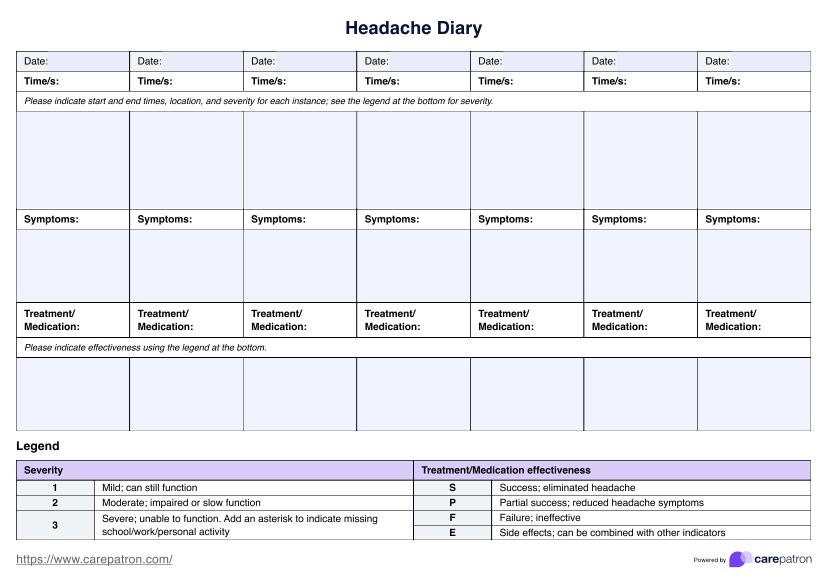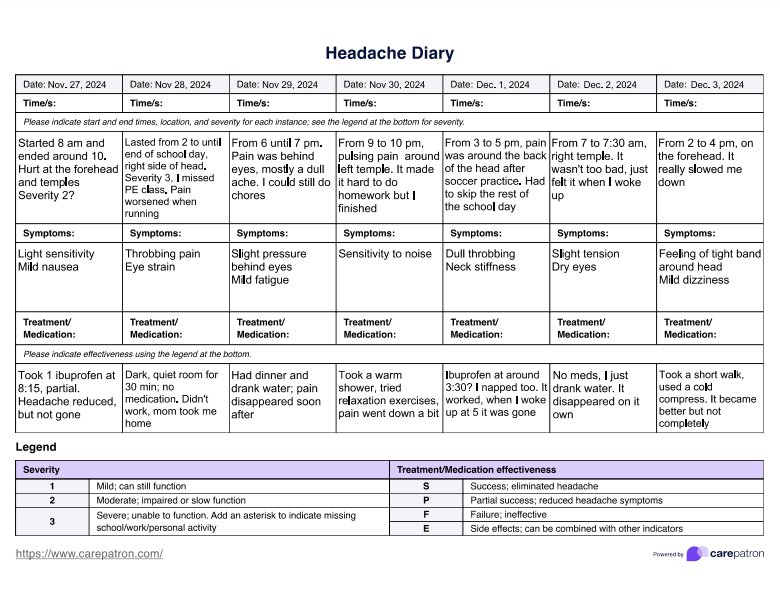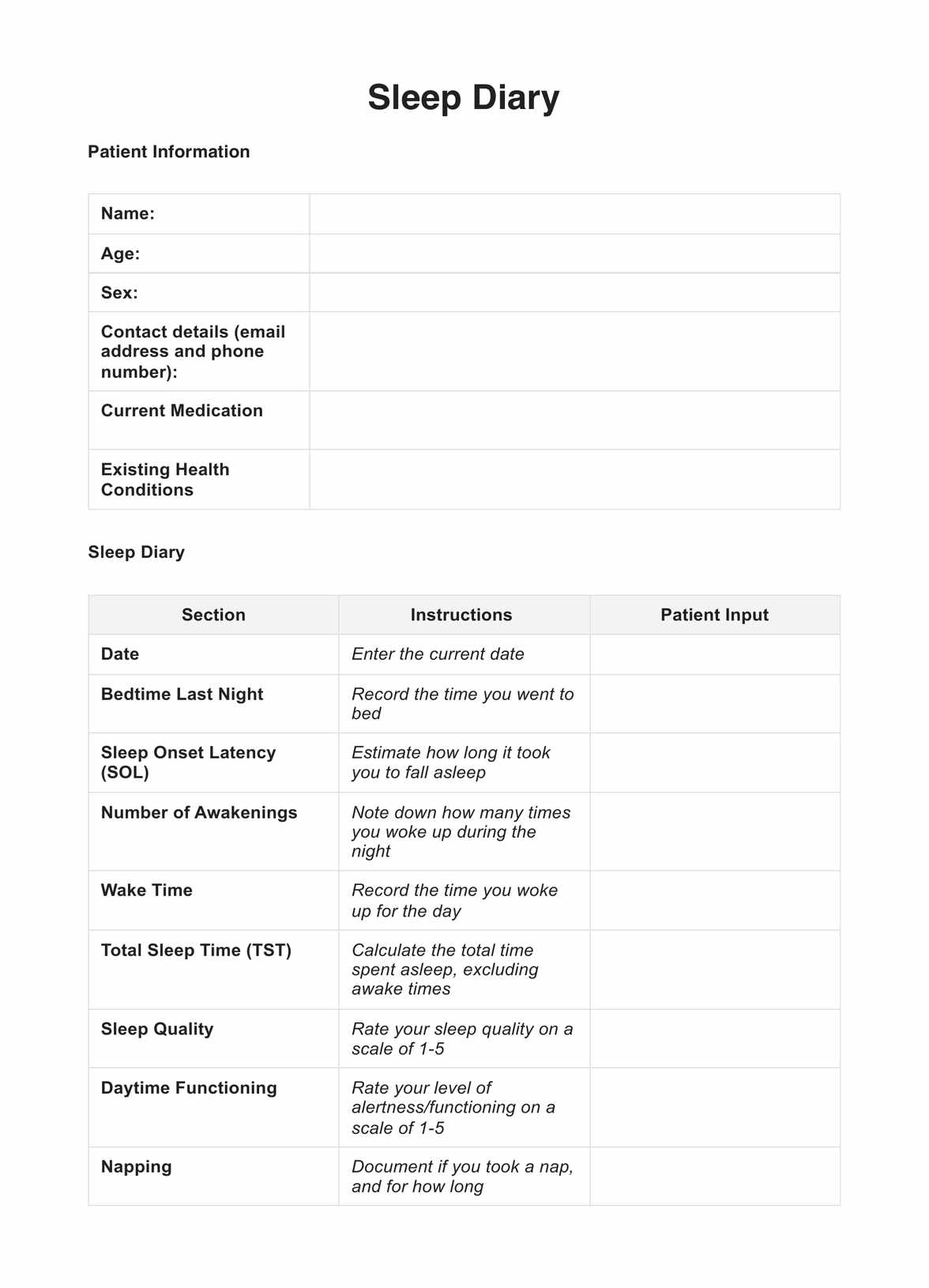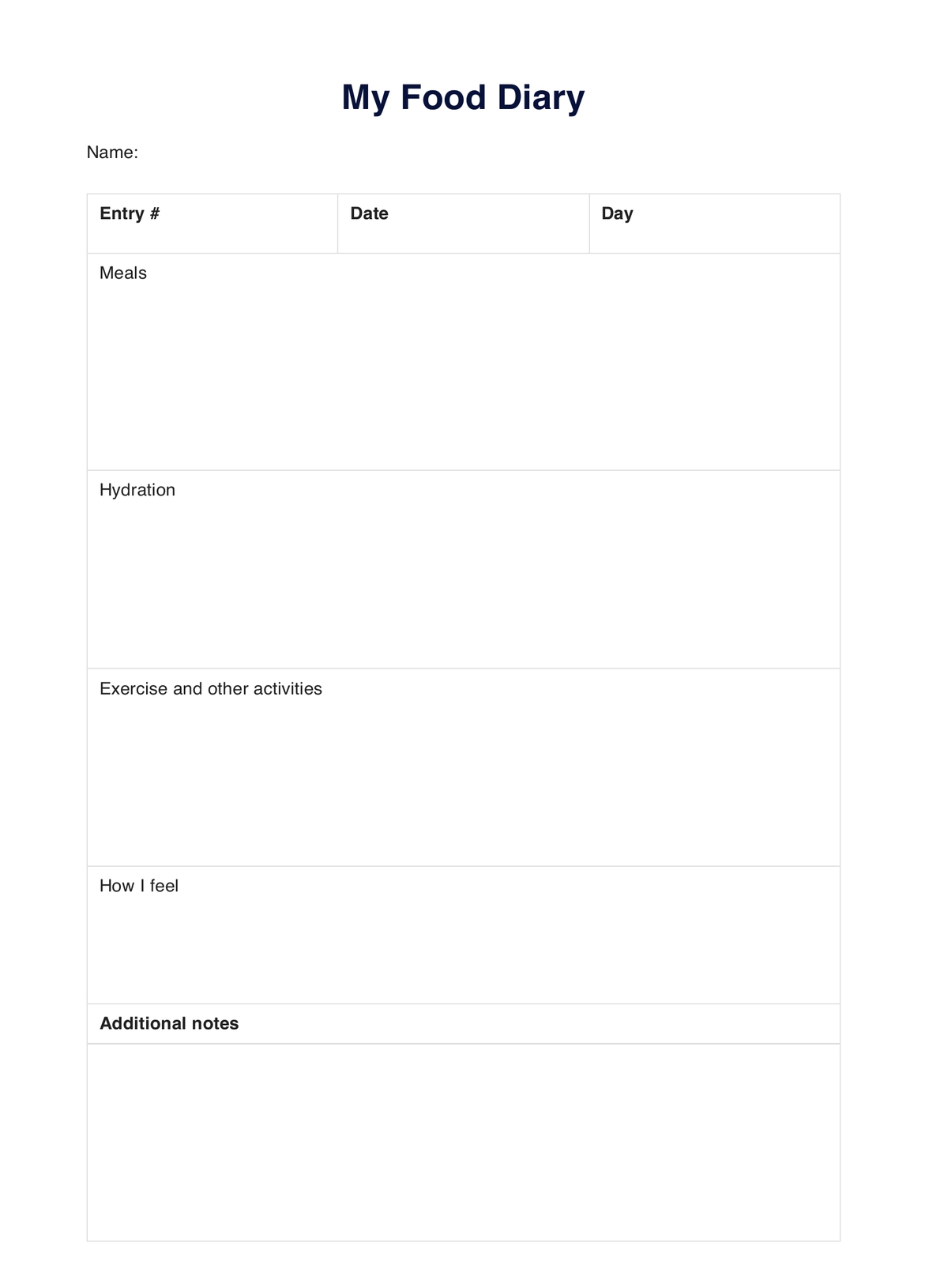Headache Diary
For effective headache management and treatment, try our Headache Diary template today—it's free on the Carepatron app!


What is a Headache Diary?
A Headache Diary, or headache journal, is a tool used by patients and healthcare professionals to track headache occurrences and other symptoms systematically. It helps identify patterns, triggers, and the effectiveness of treatments like preventive medication. By documenting when a headache began, its intensity, duration, and any associated symptoms, patients can better understand their condition.
This diary is especially useful for diagnosing and managing headache disorders, such as migraines or tension headaches. It enables healthcare providers to customize treatment plans by correlating headache patterns with triggers like diet, stress, or environmental factors. The detailed information recorded empowers patients to take an active role in their health, facilitating more informed discussions during consultations.
Headache Diary Template
Headache Diary Example
Why keep a Headache Diary?
Keeping a Headache Diary is essential in diagnosing and managing headaches. Organizations like the National Headache Foundation recommend keeping a Headache Diary as a critical part of headache management. Although we've touched on its purpose, the benefits of maintaining such a diary are manifold and deserve a closer look.
- Identifying patterns and triggers: A Headache Diary helps identify patterns and potential triggers, such as specific foods, environmental factors, or stress. This recognition is crucial in developing strategies to avoid or manage these triggers.
- Tracking effectiveness of medications: By recording the type and dosage of medication taken and the relief experienced, healthcare professionals can evaluate and adjust treatment plans more effectively.
- Understanding the impact on daily life: The diary provides insights into how headaches affect a patient's daily activities, work, and overall quality of life. This understanding can guide adjustments in lifestyle or treatment approaches.
- Facilitating accurate diagnosis: Detailed records of headache occurrences aid healthcare professionals in diagnosing the type of headache more accurately, whether it's a tension headache, migraine, or another type.
- Enhancing communication: The diary is a concrete tool for patients to communicate their experiences to healthcare professionals, leading to more productive consultations. Keeping a Headache Diary benefits both you and your patient, facilitating a comprehensive approach to headache management
- Empowering patients: When patients actively track their headaches, they gain control over their health and are more informed during healthcare discussions.
How to use our Headache Diary template
Healthcare professionals and patients use a Headache Diary jointly, facilitating a comprehensive understanding of headache patterns and effective management strategies. Here are the steps in using our template:
Step 1: Access our template
Open the Headache Diary template by clicking "Use template," on this page, which opens it on the Carepatron app's template editor. This editor lets you customize the template before printing or filling it out. You can also get a ready-to-use PDF by clicking "Download."
Step 2: Explain the template to the patient
It is crucial to clearly explain the purpose and components of the Headache Diary to the patient. You should guide patients in filling out each section, emphasizing the importance of accuracy and consistency in documenting their headache occurrences.
Step 3: Have the patient record headache details
The patient is responsible for keeping track of each headache incident, including the date, start and end time, intensity, location, accompanying symptoms, potential triggers, and medication. This detailed recording is vital for identifying patterns and triggers.
Step 4: Review and analyze the data
Review the diary with the patient, analyzing the recorded data. This review helps understand the headaches' frequency, severity, and potential causes. As the doctor, determine the most effective course of treatment, then develop or adjust your treatment plans as necessary based on the insights gained. Remember to monitor the patient's progress as well.
Headache symptoms and causes
Understanding the symptoms and causes of headaches is vital to accurately diagnose and treat them. Here are the key symptoms and causes of common headache types:
- Tension headaches: Characterized by a dull, constant ache on both sides of the head. Often linked to muscle tension, stress, poor posture, or lack of sleep.
- Migraines: Involve throbbing or pulsating pain, usually on one side of the head, with symptoms like nausea, light and sound sensitivity, and visual disturbances. Triggers include stress, hormonal changes, certain foods, and environmental factors.
- Cluster headaches: Intense, sharp pain around one eye or temple, often with symptoms like watery eyes or nasal congestion. These occur in cyclical patterns.
- Secondary headaches: Caused by underlying conditions like sinus infections, dehydration, or high blood pressure.
Recognizing these warning signs and identifying potential triggers is crucial for determining the appropriate treatment dose and approach.
Migraines vs. headaches
Understanding the distinction between migraines and headaches is critical. This knowledge aids in accurate diagnosis and treatment. Headaches are a broad category of head, face, or neck discomfort. They can vary in frequency, duration, and intensity. Common types include tension headaches, often caused by stress or muscle strain, and sinus headaches, associated with sinus infections.
Migraine attacks, however, are a specific type of headache characterized by more severe symptoms. They often present as a throbbing pain on one side of the head, accompanied by nausea, vomiting, and sensitivity to light and sound. Migraines can last hours to days, including an 'aura' phase with visual disturbances or other sensory changes.
Headache treatments
Effective management of headaches involves a combination of treatments tailored to individual needs and headache types. You should determine the most appropriate approach for each patient. Here are common strategies in headache management:
- Medication: Over-the-counter pain relievers like ibuprofen and acetaminophen are often the first line of treatment. For more severe cases, prescription medications, such as triptans for migraines, may be necessary. Certain drugs can be used for chronic headaches as a form of preventive medicine.
- Lifestyle modifications: Encouraging patients to maintain a healthy lifestyle can significantly reduce headache occurrences. This includes regular exercise, adequate sleep, a balanced diet, and hydration.
- Stress management: Techniques such as meditation, yoga, and cognitive-behavioral therapy can help manage stress, a common headache trigger.
- Physical therapy: Physical therapy can be beneficial for tension-type headaches. Techniques such as massage, heat therapy, or targeted exercises can relieve muscle tension.
- Biofeedback and relaxation training: These techniques help patients control specific body responses that can alleviate headache pain.
- Alternative treatments: Acupuncture, chiropractic care, and certain supplements like magnesium or riboflavin might benefit some patients.
- Patient education: It is crucial to educate patients about headache triggers, symptom management, and the importance of adhering to treatment plans.
Trigger management
Effective trigger management plays a vital role in reducing the frequency and severity of headaches. Since it often overlaps with lifestyle modifications, this approach focuses on identifying and addressing specific factors that provoke headaches. Here are some practical strategies:
- Identify common triggers: Tell clients to use a Headache Diary to pinpoint triggers such as certain foods, stress, weather changes, sleep disturbances, or hormonal fluctuations.
- Implement lifestyle changes: Encourage regular routines for sleep, hydration, and meals. Incorporate stress management techniques like mindfulness or yoga to reduce stress-related triggers.
- Adjust environmental factors: Advise clients to modify their surroundings to minimize exposure to bright lights, loud noises, or strong odors that might act as triggers.
- Plan for known triggers: Educate patients on planning around unavoidable triggers, such as weather changes, and avoid dietary triggers when possible.
Proactive management of these triggers can significantly enhance headache treatment outcomes.
Commonly asked questions
Keeping a Headache Diary can significantly aid in diagnosis. It gives healthcare professionals detailed insights into headache patterns, triggers, and treatment responses, enabling more accurate and personalized diagnoses.
Specific components in dairy, like tyramine, histamine, and casein, can trigger headaches in some individuals. It's crucial to track dairy consumption in a Headache Diary to determine if it's a trigger.
The 5 C's of headaches refer to common dietary triggers: cheese, chocolate, coffee, cola drinks, and citrus fruits. However, managing migraines involves more than just avoiding these items; a holistic approach to diet and lifestyle is essential for effective relief.













































































































